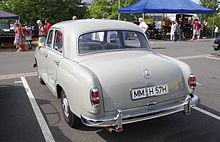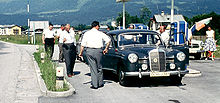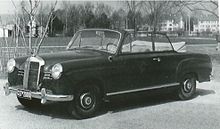Mercedes-Benz W 120
| Mercedes Benz | |
|---|---|
|
Mercedes-Benz 180 Dc (W 120)
|
|
| W 120 | |
| Production period: | 1953-1962 |
| Class : | upper middle class |
| Body versions : | limousine |
| Engines: |
Otto engines : 1.8–1.9 liters (38–50 kW) Diesel engines : 1.8–2.0 liters (29–35 kW) |
| Length: | 4485 mm |
| Width: | 1740 mm |
| Height: | 1560 mm |
| Wheelbase : | 2650 mm |
| Empty weight : | 1180-1220 kg |
| Previous model | Mercedes-Benz W 136 |
| successor | Mercedes-Benz W 110 |
The Mercedes-Benz W 120 was the first Mercedes-Benz passenger car with a self-supporting body . The upper middle class model came on the market in 1953 as the successor to the 170 (W 136) and was sold under the designation Mercedes 180 . The successor to the W 120 and its sister model, the W 121 , was the "Small Tailfin" of the W 110 series, presented in 1961 .
With the 180 D presented in 1954 and especially popular as a taxi, the widespread use of the diesel engine in passenger cars began.
Model history
General
The first Mercedes with a self-supporting body in the then modern pontoon shape replaced the model from the 1930s with free-standing fenders in 1953. Mercedes introduced the pontoon body later than other manufacturers.
Until 1957, the 180 was powered by the technically overhauled M 136 gasoline engine from the Mercedes 170 V, the design of which dates back to the 1930s. The diesel engine in the 180 D consumed 3 to 4 liters less fuel per 100 kilometers than the gasoline engine. The rear two-joint swing axle used at the beginning was considered difficult to control in bad weather conditions and was therefore replaced in 1956 by the single- joint swing axle .
While there was only a four-door sedan from Mercedes-Benz itself, the bodybuilder Binz produced different body variants. Among other things , Binz built station wagons that were sold through Mercedes dealers. The service vehicles from Mercedes-Benz were also based on this type. In order to circumvent import restrictions in South Africa , a pickup model similar to the American Ford Ranchero was also developed between 1956 and 1958 . Some of these right-hand drive vehicles were delivered complete, and some were finally assembled on site . The ambulances built by Binz had a slightly higher roof than the station wagon and a double door at the back. Other ambulances were built by the manufacturer Miesen , who, in contrast to Binz, also adjusted the height of the side windows to the greater height of the roof. Overall, emerged as 5667 "nerds", of which more than half of the 180 D .
Model variants
Mercedes 180/180 D (1953-1959)
The first pontoon appeared in September 1953, the Mercedes 180. It took over the 1.8-liter engine with 52 hp (38 kW) from its predecessor, the Mercedes 170 S. This was followed in February 1954 by the Mercedes 180 D with a 1.8-liter diesel engine with 40 hp (29 kW), also taken over from the previous model, whose output was increased to 43 hp (32 kW) in 1955.
Mercedes 180 a (1957-1959)
From July 1957, the Mercedes 180 (internal 180 a) received the more powerful 1.9-liter engine introduced in the new 190 (W 121) the previous year, but throttled to 65 hp (48 kW). Like its sister model, it was also offered with improved equipment. It had a larger Mercedes star on the hubcaps, a slightly wider grille and larger taillights. From August 1958, the 180 received the vent windows in the front doors like the 190.
Mercedes 180 b / c / 180 Db / Dc (1959–1962)
For the IAA 1959 the pontoon four-cylinder were revised. They got a wide grille and the front bumper horns were omitted. The Mercedes 180 also got the more powerful braking system of the Mercedes 190. The power of the gasoline engines was increased to 68 HP (50 kW). Internally they got the letter b. Until October 1962, the Mercedes 180 (internal code letter c) was still being built as the Mercedes 180 Dc with a diesel engine with 48 hp (35 kW) enlarged to 2 liters.
Model overview
| Construction period | The internal term | Sales description | Engine type | Displacement | Power at 1 / min |
Torque at 1 / min |
Top speed | Acceleration, 0-100 km / h |
|---|---|---|---|---|---|---|---|---|
| 1953-1957 | W 120 (180) | 180 | M 136 VII | 1767 cc | 52 PS (38 kW) / 4000 | 112 Nm / 1800 | 126 km / h | 31 p |
| 1954-1959 | W 120 (180 D) | 180 D | OM 636 VII | 1767 cc | 40 PS (29 kW) (A) / 3200 | 101 Nm | 110 km / h | 39 s |
| 1957-1959 | W 120 (180 a) | 180 | M 121 IV | 1897 cc | 65 PS (48 kW) / 4500 | 128 Nm / 2200 | 135 km / h | 21 s |
| 1959-1961 | W 120 (180 b) | 180 | M 121 IV-b | 1897 cc | 68 PS (50 kW) / 4400 | 130 Nm / 2500 | 135 km / h | 21 s |
| 1959-1961 | W 120 (180 Db) | 180 D | OM 636 VII | 1767 cc | 43 hp (32 kW) / 3500 | 101 Nm / 2000 | 110 km / h | 39 s |
| 1961–1962 | W 120 (180 c) | 180 | M 121 IV-b | 1897 cc | 68 PS (50 kW) / 4400 | 145 Nm / 2500 | 135 km / h | 20 s |
| 1961–1962 | W 120 (180 Dc) | 180 D | OM 621 IV | 1988 cc | 48 PS (35 kW) / 3800 | 108 Nm / 2000 | 110 km / h | 36 s |
photos
Mercedes 180 ambulance with Binz body
literature
- The new MB 180 with subframe. In: Motor Vehicle Technology 4/1954, pp. 111–113.
- Alexander Franc Storz: Mercedes-Benz Ponton - from the 180 Diesel to the 220 SE Cabriolet 1953 - 1962; a documentation . 1st edition, Motorbuch-Verlag, Stuttgart 2011, ISBN 978-3-613-03343-6 (Schrader type chronicle)
Individual evidence
Web links
Many details (also technical) about the W120 Ponton on MB Classic
| Vehicle class | 1920s | 1930s | 1940s | ||||||||||||||||
| 6th | 7th | 8th | 9 | 0 | 1 | 2 | 3 | 4th | 5 | 6th | 7th | 8th | 9 | 0 | 1 | 2 | 3 | 4th | |
| Compact class | W 15 (type 170) | ||||||||||||||||||
| W 23 (type 130) | |||||||||||||||||||
| W 30 (type 150) | |||||||||||||||||||
| W 28 (type 170 H) | |||||||||||||||||||
| Middle class | W 02 (type Stuttgart 200) | W 136 / W 149 (types 170 V / 200 V) | |||||||||||||||||
| W 11 (type Stuttgart 260) | W 143 (type 230 n) | ||||||||||||||||||
| W 21 (type 200/230) | W 153 (type 230) | ||||||||||||||||||
| W 138 (type 260 D) | |||||||||||||||||||
| upper middle class | W 03 / W 04 / W 05 (types 300/320/350) | W 18 (type 290) | |||||||||||||||||
| W 10 / W 19 (types 350/370/380) | W 142 (type 320) | ||||||||||||||||||
| W 22 | |||||||||||||||||||
| Upper class | Type 400 & Type 630 | W 24 / W 29 / W 129 (types 500 K / 540 K / 580 K) | |||||||||||||||||
| W 08 (type Nürburg 460/460 K / 500 / type 500 N) | |||||||||||||||||||
| W 07 / W 150 (types 770/770 K) | |||||||||||||||||||
| Sports car | Model K | ||||||||||||||||||
| W 06 (type S / SS / SSK / SSKL) | W 24 / W 29 / W 129 | ||||||||||||||||||
| Off-road vehicle | W 103 (type G1) | W 31 (type G4) | |||||||||||||||||
| W 133 III (type 170 VG) / W 139 (type 170 VL) / W 152 (type G5) | |||||||||||||||||||
| Vans | L 3/4 | L 1000 Express | L 301 | ||||||||||||||||
| L 300 | |||||||||||||||||||










